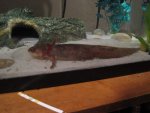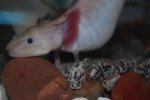JimBarnett
New member
- Joined
- Dec 12, 2009
- Messages
- 4
- Reaction score
- 1
- Points
- 0
- Location
- Bristol, England
- Country
- United Kingdom
Hi
Over the last few months my 3 year old wild type axolotl has been losing his colour and is now almost white, he still eats fine and his behaviour is still the same as its always been.
He is in a tank with a leucistic female who he has been sharing a tank with all his life, she is completely healthy and has never shown any signs of illness
Does anyone know whats happening to my axolotl?
Thanks
Jim
Over the last few months my 3 year old wild type axolotl has been losing his colour and is now almost white, he still eats fine and his behaviour is still the same as its always been.
He is in a tank with a leucistic female who he has been sharing a tank with all his life, she is completely healthy and has never shown any signs of illness
Does anyone know whats happening to my axolotl?
Thanks
Jim










